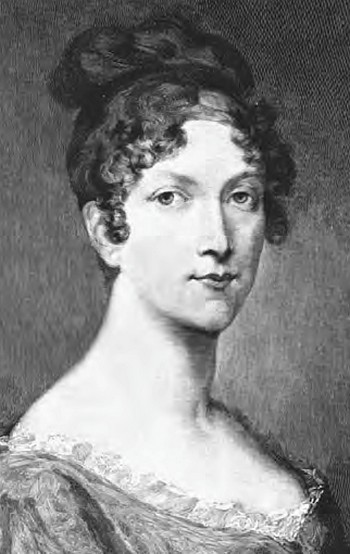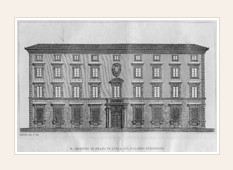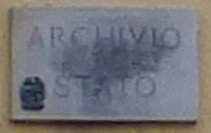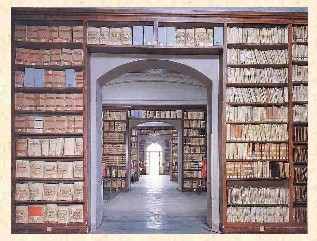Introduction
The present note is the first contribution from my recent research in the Archivio di Stato di Lucca, ASLu. In several Tuscan archives I entered for the first time in the past two years, but in Lucca, and in the ASLu in particular, I already had performed some research earlier on.
My main interest at the time was to find news on the renowned (I mean, in our field) Prince Francesco Antelminelli Castracani Fibbia, and concluded that he did never exist – this I published together with various further information coming from the ASLu and the local public Library.(1) If something better has been discovered later on, the credit goes to Andrea Vitali.(2)
Now, in visiting again the ASLu, I had the new guideline of searching, there too, the account books written by the local retailers in the 15th century, and now possibly preserved in the archive groups of hospitals, monasteries, and similar institutions. I did find some of them, as in other Tuscan archives, but still could not pinpoint any trade of playing cards recorded there.
This note clearly represents a kind of replacement: obviously, extending the search of old documents up to the 19th century is more rewarding than limiting it to the 15th century!
Even if it mainly concerns documents too early for my researches, I cannot avoid mentioning another archive in Lucca, the Archivio Storico Diocesano, in the same location since the 8th century, with documents of the early middle ages that have been acknowledged as part of Unesco’s Memory of the World.(3) If some documents are too early for me, this of course is not an absolute drawback; on the contrary, it may represent a plus point for their importance: one half of the original Longobardic documents preserved in the whole world are kept here.
Actually, I had the courage to search account books of mercers here too, but was not surprised not to find anything useful in the one book of the 15th century and the five ones of the following century that I could examine.
Archivio di Stato di Lucca, Palazzo Guidiccioni
In this long series of notes this is the first to involve Lucca and its ASLu. A short description of this important archive may thus be worthwhile. That it is a great and important archive is easy to understand, just reflecting on the long history of Lucca, the only great town of Tuscany to have remained independent from Florence.
All the main towns of Tuscany have a rich history and have kept many documents of historical relevance. Florence is clearly the biggest and most important: here it is easy to find many original documents coming from the other Tuscan towns - not however from Lucca. The documents from Lucca kept in the ASF are not enough to support any extensive study of the Lucca history; to this aim, one has to visit the ASLu.
In particular, we find in Lucca the original documents of public administrations that have lasted for many centuries, in addition to groups of documents coming from various private institutions and families. Fortunately, no particularly serious destruction or fire has occurred in the meantime and we can thus find here all the relevant documentation we are looking for.(4)
As usual, at least in Tuscany, the ASLu is located in a historical building, Palazzo Guidiccioni. This palace dates back to the 13th century - the area in which the building was erected was originally occupied by properties and towers belonging to the Guidiccioni family. The palace stands on three floors and is structured as a single large body extending along the axis of the square. In the course of time it has been modified, especially in the 17th century, with the symmetrical façade showing a portal in its centre and three regular sequences of scenic windows, increasingly simpler in advancing upwards.(5)
Principality of Lucca and Piombino
As in most other Italian states, the French conquests of initial 19th century introduced a lot of changes, which only in part were suppressed later on. The government of Lucca was directly controlled by Napoleon, who wrote its new constitution in 1805 and named as Princess his sister Elisa Bonaparte (1777-1820).(6)
Elisa Bonaparte, together with her husband Prince Felice Pasquale Baciocchi, ruled then a rather strange state composed by Lucca and Piombino, until in 1809 she was named by Napoleon the Grand Duchess of all of Tuscany.
Lucca became part of the Grand Duchy for a while, but kept a remarkable administrative autonomy even in that occasion. This means that there were traditional habits in the bureaucracy that continued unchanged, with a few up and down motions connected with abrupt and short-living transformations.
Later on, Lucca again acquired its independence and was ruled for a few years by the Duchess Maria Luisa Borbone-Spagna (1782-1824), the past Queen of Etruria.
The Amministratori dell’Octroi, and their ledger
In Lucca, the administration of customs, salt and tobacco was incorporated in 1809 into the official French “Régie des droits réunis”. However, several incomes - such as those deriving from lotteries, spirits, playing cards, flours, and abattoir - remained apart, and their collection was given to two private contractors, called “Amministratori dell’Octroi”, Rocco Felice Giannini and the Frenchman Auguste Bazin, who already belonged to the tax authorities.
This system only lasted for less than two complete years, beginning with 1 January 1810 and being suppressed on 31 October 1811.(7)
In the ASLu we have one and only one account book of Amministratori dell’Octroi, containing the records of their expenses and incomes; it represents the only source for the information contained and discussed in this note.(8)
Actually, the account books of this administration were not kept in the ASLu, where nothing existed of this kind. It has been by some sort of chance that we find here this account book of that administration. As a matter of fact, this book had originally been kept as private ownership, but was acquired for the public archives in 1826. Later on, it was catalogued in an ad hoc archive group, Amministratori dell’Octroi, containing this book only.
This is not an account book whatsoever, it is the official ledger kept by the two administrators, Bazin and Giannini, a big in folio size, 101 ff. In this ledger, all the relevant information has been recorded, even if sometimes we only find the total amount, with reference for corresponding detail to other cash books, now lost.
Understandably, I have limited myself to copy only the most useful information on playing cards, disregarding all the remaining entries.
Kinds of playing cards in common use
It may be a helpful system for our understanding that playing cards are distinguished in the records of the Lucca register according to the number of cards that are present in each pack. We also find specific attributes for given packs, but this is really an exception to the rule. As a matter of fact, each kind of pack is just indicated by two numbers, how many cards are present in the pack, how many Soldi is its price.
As for the number of cards, we recurrently find three of them, 52, 40, and 32. This is not at all a surprising finding: 52 cards correspond to the most usual complete card pack in use everywhere; 40 cards correspond to the same pack as above with the 10s, 9s, and 8s removed; 32 cards correspond to a different reduced pack, missing all the pip cards numbered from 2 to 6.
Do we thus have just three kinds of playing cards traded and used? No, we have more of them, because for a given number of cards in the pack, their quality could be different. Indeed, whereas we always find the same price for the 52-card pack, fixed at 12 s., and for the 32-card pack at 10 s., the situation is more complex for the 40-card pack.
In the case of the 40-card pack we find the “expected” price of 11 s., intermediate between the two previous ones, as intermediate is its number of cards. However, we also find higher and lower prices, and in particular 12 s., the same of the complete pack, and the significantly lower price of 8 s.
There is another pack that I must discuss, with a different number of cards; namely, the Minchiate pack. The fact that here we find no record at all for this pack is not enough for avoiding its discussion.
I have not indicated here the known number of 97 for the cards present in the Minchiate pack; as a matter of fact, there is some uncertainty concerning the number of cards available in the particular tarot packs used in Lucca.
From other towns in Tuscany, and not only from Florence, we know that playing Minchiate was not a forgotten habit at the time. This tradition evidently had vanished somewhat earlier in Lucca, because in the register under examination we no longer find any trace of Minchiate.
Ascertaining that by then Minchiate were no longer used is no less significant than providing the number of packs produced: let me thus add in the table below a further column for Minchiate, with a zero number noted for the corresponding amount – it is an arbitrary supplement, but there are good reasons for it.
Attributes of the cards
It is a seldom occurrence when we find a kind of packs indicated by some attribute, instead of, or in addition to, the number of their cards and their price. A typical way of naming the packs is according to the most traditional game they were used in playing.
We thus find, as could be expected, Faraone for the 52-card pack, Tresette for 40, and Picchetto for 32. Only Tresette is mentioned among the traditional games played with the 40-card pack, suggesting that at the time it had become the favourite game of card players in Lucca.
Possibly even more useful are some further attributes, which we sometimes find associated with the 40-card pack. As a matter of fact, we are curious to know how the presence of different prices in this case could be justified.
We have to distinguish first between 11 s. and 12 s. The former price is intermediate between those of the 52- and 32-card packs, whereas the latter and higher price is the same as for the complete pack, thus suggesting an improved quality. Now, an indication, even if certainly not exhaustive, we find in two attributes for these cards: Fiorite, and Bianche, flowery and blank, the more and the less expensive, respectively.
More intriguing are the attributes that sometimes are found for the packs priced at 8 s. In one case at least, this price is justified by calling these cards Imperfette, suggesting a price reduction due to some defects coming from the fabrication itself, or from an unsatisfactory conservation.
In rare circumstances the cards priced at 8 s. are indicated as Comuni. Actually, the cards with higher prices were in common use as well, but in this case the attribute seemingly applied to a more ordinary quality. Different from any reduction in price due to defects, this may suggests the intentional project of producing lower-cost cards.
Another minor difference in the shape of the cards, seemingly limited to those sold at s. 12, is that several colours or their combinations were used for the card borders. The corresponding information can be derived from the table in the appendix with the packs remaining available to Giuseppe Marchi at the end of the records in late 1811. Pale blue was the most frequent colour, followed by white and red.
Amount of playing cards
Some tables are provided below as appendices with numbers copied from the original records. They may be partly wrong, and some other records can be missing here. In case of a serious statistical research, if ever suitable, the ledger must be inspected again with better care.
Let me just add some rough deduction from these numbers. A first result may be the percent contribution of the various kinds to the total amount of packs. The following table reports values that I derived from the main part of the records; if one takes the whole set into account, including some packs that may have escaped my observation, different values may be obtained, but I am confident that the amendments do not modify the situation too much.

These values require some comments. The high percent of the most expensive 40-card pack is surprising. First of all, it is not usual that such a choice is done when one has three different prices available. Seemingly, the packs priced 8 s. really were defect packs, and not produced as such for a wider distribution.
However, since the best 40-card pack available had the same price as the complete 52-card pack, more sales of the latter could be expected, because one could play the traditional games requiring the 40-card pack simply by putting the 8s, 9s, and 10s aside, as is even now common here around.
It is logical to assume that there were differences in quality and in the familiar pattern of the figures that justified the results found.
On the other hand, acquiring the 40-card pack with the intention to use it also for playing the games requiring the 32-card pack was not feasible, because it was not possible to obtain the 32-card pack by just eliminating two pip cards in each suit.
In conclusion, the kinds of cards produced corresponded to the strong traditional approach of card players to their familiar cards. The most familiar were apparently the games played with the 40-card pack, to begin with Tresette; at the other limit, the Minchiate pack was no longer produced here.
Persons involved in the playing-card business
We read a lot of names in this ledger, including a few that I did not copy here. For most of them, it is not clear to me the role that they had in the production and in the control of the card distribution. Maybe the essential point is that there was one plant for the production of playing cards, and that it had Luigi Maury as head.
Apparently all the cards produced passed through the Octroi offices and were divided into groups to be transferred to some kind of subcontractors, who then cared for the following sale to distributors in the various places connected.
I am uncertain whether a more accurate study of this ledger will be enough for an interested researcher to fully reconstruct the various stages of the whole deal, or if this will require the finding of further documentation.
Conclusion
In the ASLu, a ledger is kept with the administration of several concessions provided in 1810-11 to two private citizens, including that of playing cards. Here, the corresponding expenses and incomes have been recorded, which provide us with several useful and quantitative information on the local production and use of playing cards.
No Minchiate or tarot pack was produced any longer. Packs available had 52, 40 or 32 cards. The most used was the 40-card pack, of which three different qualities existed – the most familiar was the most expensive of them, which had the same price of the complete 52-card pack, namely 12 s.
Footnotes:
(1) The Playing-Card, 24 N. 5 (1996) 134-141.
(2) Letarot.it (Andrea Vitali): Il Principe.
L'ideatore del Ludus Triumphorum. Translation to English: The Prince. The creator of the Ludus Triumphorum. By Michael S. Howard
(3) diocesilucca.it
(4) archiviodistatoinlucca.it
(5) exploro.it
(6) Wikipedia: Principality of Lucca
(7) Salvatore Bongi, Inventario Archivio di Stato in Lucca Vol. 3. Lucca 1880.
(8) ASLu, Amministratori dell’octroi, 1.
APPENDICES
1 - Records of card packs in various hands
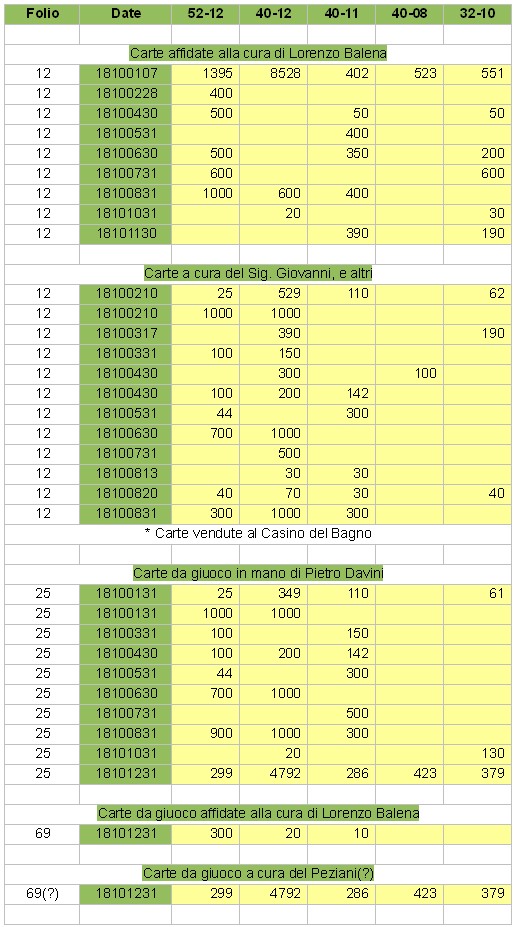
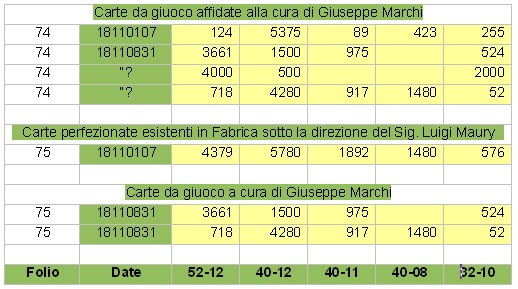
In a few cases, the number of packs is the sum of two or more entries recorded in the same list. The date is clearly in the format yyyymmdd.
2. Information on card borders
Per valuta delle infrascritte qualità di carte rimaste in consegna del suddetto [Giuseppe Marchi] per il semplice conto di s. 6 il mazzo i quali si distinguono come appresso (fol. 74):*
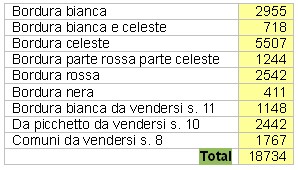
* The date is not indicated, it may be 31 August 1811, or a following day up to 31 October 1811.
|
|




